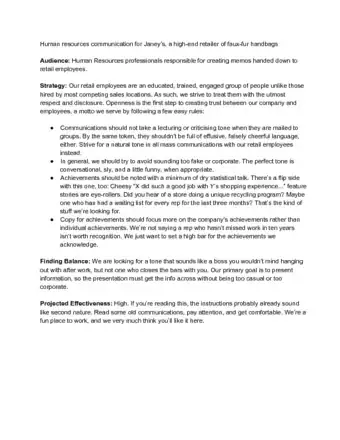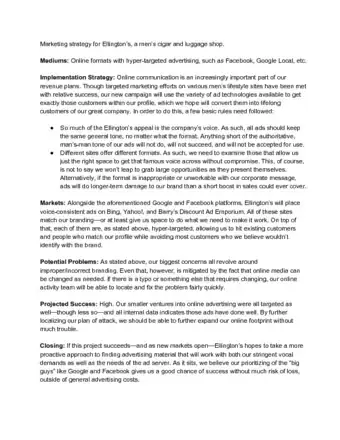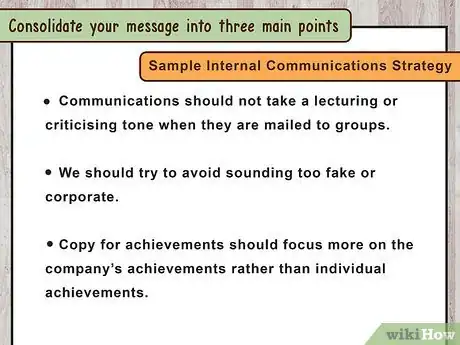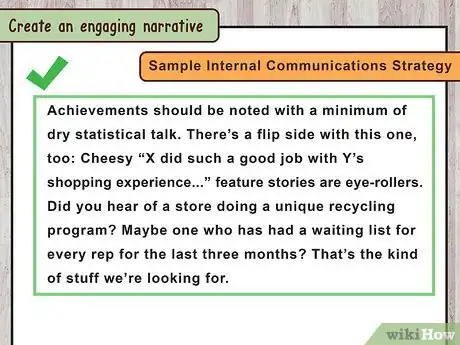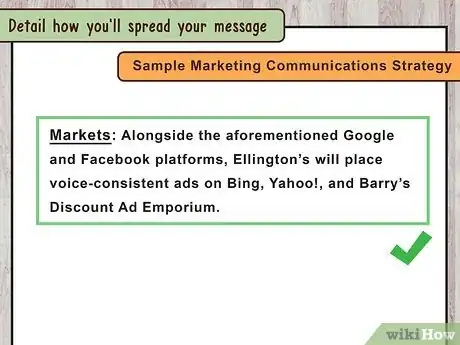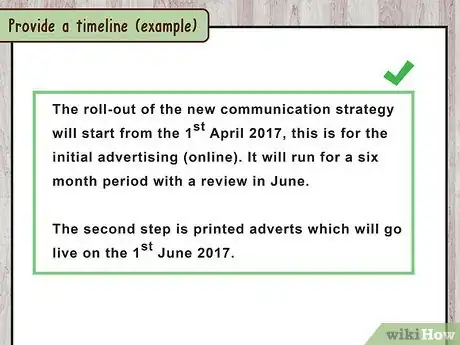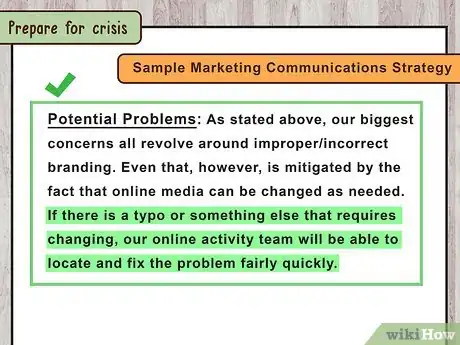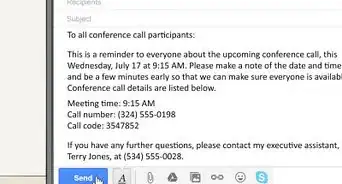This article was co-authored by Archana Ramamoorthy, MS. Archana Ramamoorthy is the Chief Technology Officer, North America at Workday She is a product ninja, security advocate, and on a quest to enable more inclusion in the tech industry. Archana received her BS from SRM University and MS from Duke University and has been working in product management for over 8 years.
wikiHow marks an article as reader-approved once it receives enough positive feedback. This article received 14 testimonials and 88% of readers who voted found it helpful, earning it our reader-approved status.
This article has been viewed 530,535 times.
A communications strategy, or plan, is a document that expresses the goals and methods of an organization's outreach activities, including what an organization wishes to share with the public and whom the organization is trying to reach. According to Chief Technology Officer Archana Ramamoorthy, there are a few key things to keep in mind when developing a communications strategy. First, it should tell your audience why they should be interested in your product -- what problem are you solving? Second, it should be tailored to that specific audience, targeting the people most likely to care about your product. Finally, it should reflect your company's core values and mission statement.
Steps
Sample Communications Strategies
Establishing Your Objectives
-
1Consider the long- and short-term goals of your organization. Whatever you do should be in support of these goals, so it is important to be clear on them.[1]
- Indicate what your organization wishes to achieve on the communications front, such as increased media prominence, damage control, branding, etc.
- For instance, growth may be your company's long-term goal, while creating greater brand recognition locally is your short-term goal.
-
2Define objectives that support your company's goals. Define your objectives as clearly as possible. Explain why each objective is relevant. Your goals should be specific enough that their success or failure should be easy to establish after they have been implemented. They should also be flexible enough to be adjusted in the case of possible changes.[2]
- If your company is aiming to grow by means of establishing greater brand recognition locally, your communications strategy may be "Create brand recognition in those local communities that are less familiar with our product, in order to attract more vendors within those neighborhoods."
Advertisement -
3Identify the audience of your communications. Name the populations and individuals you are trying to reach, such as the general public, a media outlet, invested individuals, or others. Remember to consider all the stakeholders in your organization. List your audience.[3]
- Of those listed, who is it most important to reach? Rank your list. For instance, while it usually makes sense to get more media exposure, there are times when it's even more important to communicate with key stakeholders.
- For instance, you may define your most important audience as community members within a few neighborhoods in which brand recognition for your company is especially low.
- When you have completed your draft, go back and make sure that you have a plan to reach all of the stakeholders you listed.
-
4Translate your communications objectives into actions. Describe the activities you will undertake to achieve your objectives. It isn't helpful to present goals alone: lay out the work you will do to achieve them. Explain what you will do for media outreach, public relations, and customer care.
- If you are trying to drum up local recognition of your brand, for instance, your actions may be something like "Take out ads in local papers," or "Sponsor community soccer leagues."
Delivering Your Message
-
1Consolidate your message into three main points. Your points should be concise so you can return to them many times. Put the most important point first. Explain how each point will be transmitted to each target audience.[4]
- For instance, your message might be that your product is readily available, that it is more reliable than other options, and that it is appreciated by children and adults alike.
-
2Create an engaging narrative. Communications is all about storytelling, and there's no reason the strategy should be any more dry than the narrative it will eventually produce. Craft a story arc with your presentation. Include human interest anecdotes, vivid narrative, and intriguing images.[5]
- To define a narrative, position your company or your team as a hero embarking on a mission. Define the motives, risks, and benefits in terms of a hero's journey that will have a happy ending.
- For instance, you might say, "After succeeding in select markets in Dayton, Ohio, our company has reached a plateau. We have secured vendors within all of the University-affiliated neighborhoods, and our customers couldn't be happier. Sure, we have a loyal customer base, but many of our customers will move after a few years. How can we build greater brand recognition within the permanent residents of Dayton, enough that we can expand our operations to Cincinnati? To Columbus?"
- Follow this setup by laying out your plan, and detail the positive outcome you project.
-
3Detail how you'll spread your message. Describe the forms that your messages will take and how they will be disseminated, including details about mailings, social media platforms, media destinations, etc.[6]
- List any media contacts, public relations arrangements, social media services, etc. If your goal is to reduce coverage or scrutiny of your organization, identify specific methods for deflecting attention.
-
4List your resources. Describe the resources or budget that you will use to support your communications strategy. This may include technology, teams or individuals in your company, anything you'll need to purchase and resources your company already has. Include projections of future costs.[7]
- Verify any parts of the plan you are unsure of with those in charge of your company's budget.
-
5Provide a timeline. Draw up a calendar detailing the proposed implementation of your communications strategy. Set definite benchmarks as barometers of progress. Make sure to leave enough time for the each part of the process.[8]
- Ask, does this give us enough time for the project to be seen by everyone who has to see it?
Including Additional Strategies
-
1Propose methods for evaluating the success of your strategy. Include information about any surveys you hope to conduct, results you hope to see at certain dates, responses you wish to receive from individuals or media organizations, etc. Ensure that there is a definite way to gauge whether your strategy has failed or succeeded.[9]
- Identify ways in which your strategy can be adapted to changing conditions and how you will respond to feedback from within and from outside the organization.
-
2Prepare for crisis. Include a crisis communications plan within your communications plan. Explain what will you do if this strategy goes wrong. List possible weaknesses you will be prepared to address. Make sure to include a plan for keeping your beneficiaries safe.[10]
-
3Specify your digital strategy. While you probably cover many digital platforms in your initial plan, you may want to draw up a specific strategy for increasing your company's digital presence. Identify the areas where you company needs to grow: is the website effective? Is social media being used effectively? How easy will it be for customers to react to your communications across platforms?[11]
- Present this alongside your company's communications strategy.
Community Q&A
-
QuestionHow do I develop a communication strategy for a disease?
 Community AnswerNo differently than you would for anything else. The tips in the article pertain to anything.
Community AnswerNo differently than you would for anything else. The tips in the article pertain to anything. -
QuestionI am in an organization which is tasked to prevent HIV infections and advocacy and policy developments are our effort to coordinating service providers to this cause. How can I make a communication strategy?
 Mb_0747f85dd635Community AnswerIt depends on what are your communications objectives: Do you want to create awareness, disseminate information, change attitudes and/or behaviours or attract some donations? Who exactly do you want to approach with your message? Start with these main questions and afterwards, once the goal is clearly established, continue with the strategy itself, in particular what to say (message strategy), how to say it (creative strategy), who should say it (message source).
Mb_0747f85dd635Community AnswerIt depends on what are your communications objectives: Do you want to create awareness, disseminate information, change attitudes and/or behaviours or attract some donations? Who exactly do you want to approach with your message? Start with these main questions and afterwards, once the goal is clearly established, continue with the strategy itself, in particular what to say (message strategy), how to say it (creative strategy), who should say it (message source).
References
- ↑ https://www.odi.org/publications/5186-planning-tools-how-write-communications-strategy
- ↑ https://thecompassforsbc.org/how-to-guide/how-develop-communication-strategy
- ↑ https://www.ox.ac.uk/sites/files/oxford/media_wysiwyg/Writing%20a%20communications%20strategy%20%2818.02.16%29.pdf
- ↑ https://thecompassforsbc.org/how-to-guide/how-develop-communication-strategy
- ↑ https://www.ucanwest.ca/blog/business-management/importance-of-communication-strategy-within-an-organization/#fs-panel-3788
- ↑ https://www.ox.ac.uk/sites/files/oxford/media_wysiwyg/Writing%20a%20communications%20strategy%20%2818.02.16%29.pdf
- ↑ https://www.odi.org/publications/5186-planning-tools-how-write-communications-strategy
- ↑ https://www.odi.org/publications/5186-planning-tools-how-write-communications-strategy
- ↑ https://www.odi.org/publications/5186-planning-tools-how-write-communications-strategy
About This Article
To write a communications strategy, write down the long-term and short-term goals of the company, and define a few relevant objectives that will help the company meet those goals. In the strategy, identify the audience of your communication, such as stakeholders, media outlets, or the general public. Then, translate these objectives into actionable steps that you can take to help the organization achieve its goals. Try to limit the strategy to 3 main points, and use a narrative to tell the audience more about the organization. For tips on delivering the message effectively and including additional strategies, read on!
